
Kiviuq is a prograde irregular satellite of Saturn. It was discovered by J. J. Kavelaars et al. in 2000, and given the temporary designation S/2000 S 5. It was named after Kiviuq, a hero of Inuit mythology.
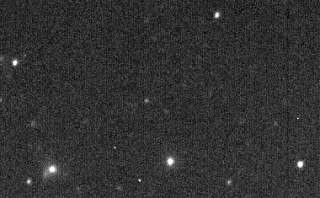
Erriapus, or Saturn XXVIII (28), is a prograde irregular satellite of Saturn. It was discovered by Brett Gladman, John J. Kavelaars and colleagues in 2000, and given the temporary designation S/2000 S 10. It was named Erriapo in August 2003 after Erriapus, a giant in Gaulish mythology; the name was changed from dative Erriapo to nominative Erriapus per IAU conventions in late 2007.

Jean Mueller is an American astronomer and discoverer of comets, minor planets, and a large number of supernovas at the U.S. Palomar Observatory in California.
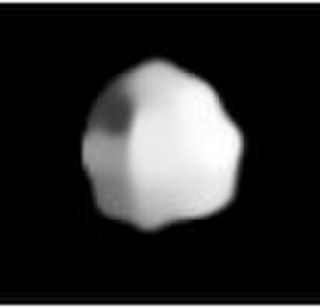
18 Melpomene is a large, bright main-belt asteroid that was discovered by J. R. Hind on 24 June 1852, and named after Melpomenē, the Muse of tragedy in Greek mythology. Its historical symbol was a dagger over a star; it is in the pipeline for Unicode 17.0 as U+1CECB .

A transit of Deimos across the Sun as seen from Mars occurs when Deimos passes directly between the Sun and a point on the surface of Mars, obscuring a small part of the Sun's disc for an observer on Mars. During a transit, Deimos can be seen from Mars as a small dark spot rapidly moving across the Sun's face.
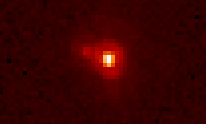
(55637) 2002 UX25 (provisional designation 2002 UX25) is a trans-Neptunian object that orbits the Sun in the Kuiper belt beyond Neptune. It briefly garnered scientific attention when it was found to have an unexpectedly low density of about 0.82 g/cm3. It was discovered on 30 October 2002, by the Spacewatch program; as of August 2024, the object has yet to be named.

65P/Gunn is a periodic comet in the Solar System which has a current orbital period of 6.79 years. The comet is a short-period comet, orbiting the Sun every 6.79 years inside the main asteroid belt between the orbits of the planets Mars and Jupiter.

Salacia is a large trans-Neptunian object in the Kuiper belt, approximately 850 km (530 mi) in diameter. It was discovered on 22 September 2004, by American astronomers Henry Roe, Michael Brown and Kristina Barkume at the Palomar Observatory in California, United States. Salacia orbits the Sun at an average distance that is slightly greater than that of Pluto. It was named after the Roman goddess Salacia and has a single known moon, Actaea.
122P/de Vico is a periodic comet with an orbital period of 74 years. It fits the classical definition of a Halley-type comet with. It was discovered by Francesco de Vico in Rome on February 20, 1846.
163P/NEAT is a periodic comet discovered on November 5, 2004 by Near-Earth Asteroid Tracking (NEAT) using the 1.2 meter Samuel Oschin telescope at Palomar Observatory.

125P/Spacewatch is a periodic Jupiter-family comet. It was discovered on September 8, 1991, by Tom Gehrels using the 0.91 m Spacewatch telescope at the Kitt Peak National Observatory. It was the first comet discovered with the use of a CCD and also the faintest comet upon discovery up to that point. It has a diameter of 1.6 km.

Comet 252P/LINEAR is a periodic comet and near-Earth object discovered by the LINEAR survey on April 7, 2000. The comet is a Jupiter family comet, meaning that it passes quite close to the orbit of Jupiter.

126P/IRAS is a periodic comet with an orbital period of 13.4 years. It was discovered in images taken by the Infrared Astronomical Satellite (IRAS) on 28 July 1983 by J. Davies. The discovery was confirmed with images taken with the 1.2-m Schmidt telescope at Palomar Observatory.

Comet 141P/Machholz or 141P/Machholz 2 is a periodic Jupiter family comet with an orbital period of 5.3 years. It was discovered by Donald Machholz on 13 August 1994. A few days after the discovery a number of condensations were found near the main component of the comet, indicating that the comet had fragmented between 1987 and 1989, during its previous perihelion.

207P/NEAT is a periodic Jupiter-family comet with an orbital period of 7.62 years. It was discovered by Near Earth Asteroid Tracking (NEAT) on 11 March 2001.

210P/Christensen is a Jupiter family periodic comet with an orbital period of 5.7 years. It was discovered by Eric J. Christensen on 26 May 2003 in images taken by the Catalina Sky Survey and recovered in images obtained by STEREO, the first time a single-apparition comet was recovered by a spacecraft.

(164121) 2003 YT1, provisional designation 2003 YT1, is a bright asteroid and synchronous binary system on a highly eccentric orbit, classified as near-Earth object and potentially hazardous asteroid of the Apollo group, approximately 2 kilometers (1.2 miles) in diameter. It was discovered on 18 December 2003, by astronomers with the Catalina Sky Survey at the Catalina Station near Tucson, Arizona, in the United States. The V-type asteroid has a short rotation period of 2.3 hours. Its 210-meter sized minor-planet moon was discovered at Arecibo Observatory in May 2004.
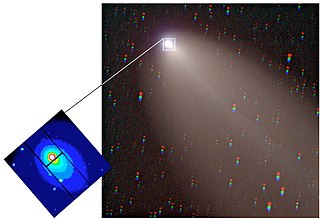
C/2000 WM1 (LINEAR) is a non-periodic comet discovered by LINEAR on 16 December 2000. The comet brightened to an apparent magnitude of about 2.5.

C/2001 A2 (LINEAR) is a non-periodic comet from the Oort cloud discovered by LINEAR on 15 January 2001. The nucleus of comet split in multible fragments during its perihelion passage. The comet brightened to an apparent magnitude of about 3.
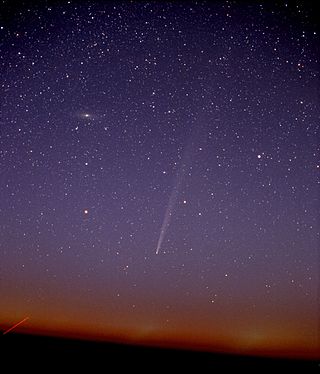
C/2004 F4 (Bradfield) is a non-periodic comet discovered by amateur astronomer William A. Bradfield on 23 March 2004. The comet brightened to an apparent magnitude of about 3.3.




















